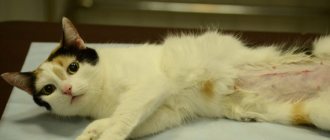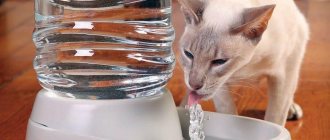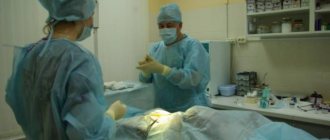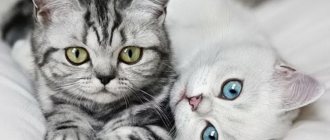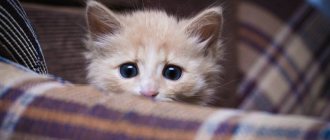Possible postoperative complications
If a cat does not eat or drink after surgery, this makes the owners worry, so the question arises of how to help their pet and whether this may indicate the presence of serious complications.
After sterilization, it takes time to recover
It is absolutely normal for a cat to eat poorly after sterilization or a cat after castration during the first 24 hours. All the animal does is sleep and sometimes get up to drink some water.
Important! If the animal cannot get up on its own to drink water, then it must be given water periodically.
In addition, there is no need to panic if the cat goes to the toilet under itself or vomits; this is also quite possible until the threads are removed from the seam. Veterinarians recommend that owners do not touch the cat during the first two days and, if it does not want to eat, there is no need to force food. The animal will be able to go without food for several days, while its body will use up previously accumulated calories to maintain satiety.
The postoperative period will be painful for the cat, but it will gradually recover. In addition, she will receive injections to maintain fluid balance.
The animal needs to be allocated a secluded corner that will be quiet and calm so that the cat can rest and get enough sleep. You should definitely put a bowl of fresh food nearby.
Note! If there are other animals in the house besides the cat, they must be isolated until the sterilized animal is completely restored.
If a cat does not eat or drink for several days after sterilization, then you should urgently seek veterinary help, because such a condition may indicate the development of serious diseases.
Postoperative complications may be as follows:
- development of sepsis;
- intestinal atony or obstruction;
- kidney or liver problems;
- hernia;
- inflammation of the peritoneum;
- infectious infection;
- suppuration of the sutures or their divergence.
Complications after surgery can vary
If at least one negative symptom appears, you must seek help from a specialist; treatment at home is unacceptable, because there is a threat to the pet’s life.
Refusal of water on the first day after sterilization
It is considered normal if a cat refuses to drink water on the first day after sterilization. The cause may be nausea resulting from anesthesia. But this condition cannot be ignored, since a decrease in the amount of fluid in the animal’s body negatively affects the functioning of all internal organs and systems
During this period, it is important to prevent the development of dehydration by intravenous or subcutaneous injections of saline solution
Unfavorable factors that accelerate fluid loss include:
- vomit;
- diarrhea;
- stress;
- preoperative fasting diet;
- increased salivation;
- blood loss.
In addition, anesthetic drugs contain substances that bind and remove water molecules from the body.
Anesthesia is the cause of lack of appetite
Cat after sterilization: care at home
During surgery, veterinarians use general anesthesia as it helps numb the surgical site. Another advantage of anesthesia is that the cat will not escape from the operating table and will not inflict even greater injuries or mutilation on itself.
But the effect of anesthesia after the operation does not go away without a trace, and the cat recovers from it for a long time: it may take a long time to wake up, breathe heavily, eat nothing and move unsteadily - and all this is the norm.
In rare cases, an animal can be in a comatose state for a week: refuse to eat, sleep constantly and practically not move. But all this goes away over time without additional help.
If a cat does not drink water after anesthesia, then this is also quite normal, since it may vomit after drinking water or food. Therefore, you should be patient, and very soon your pet will recover.
Pulmonary edema in a cat after sterilization
Long gone are the days when pets were anesthetized “by eye,” and the owners begged the doctor “not to overdo it.” Now veterinary clinics have modern and safe means of anesthesia. Large clinics use inhalation anesthesia and epidural anesthesia. Despite this, general anesthesia can cause dangerous complications in cats after sterilization.
If your cat has problems with the heart muscle (hypertrophic cardiomyopathy, congenital defects), pulmonary edema or thromboembolism may develop after surgery. Both complications can lead to the death of the animal, even if the owner notices something is wrong in a timely manner and consults a doctor.
As a doctor, I recommend doing a cardiac ECHO (ultrasound) before surgery. So we can be calm or, on the contrary, look for options for anesthesia and medicinal support. In practice, owners most often refuse the study to cut costs. With the words “Yes, this is a cat, what will happen to her.” To be fair, I note that most cats do tolerate anesthesia well. But there are breeds in which HCM (hypertrophic cardiomyopathy) occurs much more often than in outbred cats. Here are some popular cats that are at risk:
- Maine Coons;
- Sphinxes;
- British cats;
- Scottish cats.
Scottish Fold ECHO of the heart is a must
Owners should monitor their cat for at least two weeks after sterilization. The pet should eat, drink, and play as usual within 24 hours. If a cat refuses to eat, lies in one place, breathes with its mouth open like a dog, you should immediately contact a well-equipped clinic for diagnosis.
What to do if the animal refuses to eat
Owners begin to worry if the cat does not eat after surgery, what to do in such a situation and why does this happen? In this case, you should consult a specialist, as complications may arise.
How long does it take for a cat to recover from anesthesia after sterilization: how you can help
The animal must be fed three times a day with kefir, broth or meat puree, but in small portions. This can be done using a syringe without a needle, pouring food carefully into the cheek. It is also recommended to place an intravenous drip with nutrition.
Important! If the cat does not eat anything or go to the toilet for a long time, it means that some complication could have developed.
It is very important to ensure that your cat goes to the toilet regularly, because constipation can cause her to refuse to eat. To determine whether the cause is really constipation, it is worth palpating the stomach and, if there are lumps, give an enema or give the animal a laxative.
Refusal to eat after surgery usually lasts several days
After the operation, the cat must be wearing a blanket, which prevents licking the wound and scratching it. The owner’s task in this case is to care for the wound, since its deterioration can also affect the animal’s complete lack of appetite.
If no complications were confirmed by the veterinarian, then after 10 days the pet will be able to fully recover and begin to eat normally.
Recovery from cat anesthesia after sterilization
After surgery, monitoring the cat's temperature is required! An ordinary mercury thermometer is suitable for this.
- At first, there is a lack of coordination of movement, involuntary running, and lameness.
- The cat may stand unsteadily on its paws, fall over on its side, or try to remove the restraining bandage or blanket.
- Possibly a plaintive meow.
- Uncontrollable urination often occurs.
- For persistent and prolonged nausea and vomiting, consult a veterinarian. Such signs may indicate complications that have arisen.
- In some cases, an increase in body temperature may occur. You should constantly touch your pet's nose. With hyperthermia, it will be dry and hot to the touch. If in doubt, you should measure her temperature with a thermometer. You cannot use a regular mercury thermometer for this; it is recommended to use an electronic device. The temperature of cats and cats is measured rectally. It is better if the owner has an assistant, since the animal does not like such a procedure and will resist, which can result in damage to the integrity of the suture and painful sensations for the operated patient. The tip should be inserted into the anus and held until the signal. If the temperature persists for more than four hours after waking up, going to the clinic is mandatory.
In the first time after recovery from anesthesia, there is a lack of coordination of movement.
Do not feed or water your cat after anesthesia
You should not feed and water your pet immediately after waking up.
Water can be given four hours after sterilization. If the patient overslept during this time and has not yet recovered from anesthesia, then it is permissible to offer a drink immediately after waking up.
4 hours after surgery, the cat can be given water.
It is recommended to feed twenty-four hours after the operation. Often the operated pet has a reduced appetite or no appetite at all. Force feeding is not allowed. The pet will decide when she can eat.
If there is a lack of appetite and activity for a fairly long period, and at the same time there are other alarming symptoms, you should immediately contact the clinic.
In the first days, do not make changes to your cat's diet.
It is recommended to feed with your usual food, as before the procedure. When consuming dry food before sterilization, it is recommended to give your pet a special post-operative dry food designed specifically for such cases. If there is a rapid heartbeat or breathing, or increased blood pressure, this is a sign of a painful syndrome in the wound area.
After the procedure, the cat should be fed with the cat’s usual food.
In total, the cat should fully recover within 24 hours. If this does not happen, you need to consult a doctor.
A day after the operation, the cat fully recovers.
Feeding after surgery
In order for your cat to recover quickly after surgery, you should monitor its diet. Proper nutrition is the key to a quick recovery and prevention of complications.
The cat does not drink water at all: what to do, why
During the first two days, the animal may not eat anything at all, and this is normal. During the first day, the cat should not be given solid food; it is better to cook broths or soups. On the second day, you should start feeding with soft food or crush the food into a puree. It is recommended to feed in small portions 3-4 times a day.
After surgery, the animal loses a lot of minerals and vitamins and it is very important to compensate for their deficiency in the body, so experts recommend buying special cat food that has high nutritional value and a balanced composition.
If the animal eats homemade food, then you should avoid foods with a strong smell and spices. It is also prohibited to give dry food during the postoperative period; it must be pre-soaked with water, but the main emphasis after the operation should be on eating canned meat and purees.
Important! When feeding your cat, you should make sure that the food is neither hot nor cold. It should be at a comfortable temperature for consumption.
Reasons why a cat trembles after sterilization
Any abdominal operation, including defertility of a cat, is not easily tolerated by the animal’s body.
The pet's body requires a lot of strength and energy to fully recover from its effects.
Blood loss
Blood loss is of particular importance. In total, the average pet’s body rarely contains more than 200-230 ml of blood. During a normal abdominal operation, a cat can lose up to 15-20 ml of “life-giving fluid”.
Taking into account its total volume in the body, such a loss cannot pass without a trace: the animal after the operation will not feel very well in any case. This is one of the causes of postoperative tremor (shaking). But in practice, the reasons for postoperative “shaking” are much more diverse.
Changes in thermoregulation
In particular, the body's systems do not operate in their usual mode after surgery. This especially applies to the body's thermoregulation system. She suffers from the same blood loss and enormous energy expenditure on the regeneration processes that are actively occurring in the animal’s body.
There is no longer enough strength to maintain a stable temperature of the internal organs and skin. The consequence of this is trembling: rapid and rhythmic muscle contractions are needed for the “idle” burning of ATP, accompanied by the release of heat.
If a pet is operated on at the age of two or three years, and it has reserves of subcutaneous fatty tissue, then its body can heat itself for quite a long time, without problems arising. They appear if the animal is young and has not had time to accumulate such reserves.
If for some reason the regeneration process is delayed, the reserves are quickly depleted. The situation is aggravated by the fact that in this state the cat does not have a special appetite, and therefore her body has nowhere to take energy from. The combination of these factors can lead to severe hypothermia (hypothermia). If you do not follow the simplest rules of caring for an operated animal, it may simply freeze to death.
Side effects of anesthesia
There is another important reason for post-operative tremor. It's all about the "side effects" of the drugs used during anesthesia. All of them are poisonous to one degree or another, all have one or another side effect. Trembling is one of the most typical consequences of their use. This is especially true in the case of outdated drugs, which can have a whole “bouquet” of undesirable effects of use.
Inflammatory pathologies
Unfortunately, another common cause of severe shaking is much more dangerous. We are talking about postoperative inflammatory pathologies.
The activity of microbes predictably leads to the development of inflammation, and as is known, it is often accompanied by fever of a constant or intermittent type. It is this that causes severe and often constant trembling. If your cat's body is hot to the touch, you should immediately contact your veterinarian: if you delay, the consequences will be too severe.
Rules for feeding a sterilized cat
It is necessary to start feeding the cat only 12 hours after surgery, since during this time the animal’s gastrointestinal tract does not work well, and it may vomit after eating.
When compiling further menus, it is imperative to take into account how the animal ate before sterilization. The most acceptable are cat foods, since they contain balanced components necessary for a pet.
Food for a sterilized cat
- First day. A cat does not eat well after sterilization for 24 hours; this is normal. This is the period when the animal is completely exhausted and cannot show interest in food or water. You can give your cat water a few hours after the operation, but before that you can only moisten a little sponge or drop a couple of drops of water on the tongue to avoid dehydration.
- Second day. If there are no complications, the animal may begin to show interest in food, and it is worth feeding it with special cat food. You should choose those whose action is aimed at restoring the body after operations or illnesses. It is worth opting for canned food such as Royal Canin, Hill's, Purina, etc. But if before the operation the animal was home-fed, then it should be boiled chicken broth and add a little twisted meat.
- The third day. The cat should begin to eat on its own without any help. But if this is not observed, you should pay attention to the pet’s behavior. If she meows, there is an unpleasant odor coming from the stitches, or the wound is bleeding, then the animal should be immediately shown to a doctor.
- Fourth day. If the cat still does not eat anything, then this most likely means the presence of complications such as peritonitis, sepsis or problems with the gastrointestinal tract. If the cat ate normally for the first four days, and then suddenly began to refuse to eat, this may mean the occurrence of delayed intestinal atony or problems with the liver or kidneys. The fourth day without food after surgery may mean that the cat is dying, so you need to drop everything and run with it to the veterinary clinic.
- Fifth day. You can already start giving everything that the animal ate before surgery. But if during the first five days the cat took food reluctantly, and sometimes even refused it altogether, then it can lose a lot of weight, and in this case it is necessary to introduce high-quality food into the diet and take additional medications that are prescribed only by a veterinarian.
Many animals recover easily and quickly after surgery.
If the cat does not drink after sterilization or does not eat anything after two days, then you should seek help from a veterinarian, who will identify the complication in time and give further recommendations for treatment.
Condition of the cat immediately after sterilization
The well-being of a cat after sterilization depends on several factors:
- age at the time of surgery;
- whether the procedure was planned or emergency;
- type of anesthesia used.
Is the animal in pain?
After recovering from anesthesia, the animal may experience pain, which usually goes away on the second day. The main signs of postoperative pain are:
- manifestation of aggression;
- dilated pupils;
- prolonged immobile stay in one position;
- gaze directed at one point;
- refusal to eat.
To alleviate your pet's condition, you should give her a painkiller injection or give her an anesthetic drug orally.
Why might a cat be overly active?
Postoperative behavior depends on the individual characteristics of the cat, its psyche and stress tolerance.
After sterilization, some animals may consider themselves completely healthy, not feel any discomfort, continue to lead their usual lifestyle, or become hyperactive.
This behavior negatively affects the recovery process. Due to increased activity, a cat may bite, scratch, show aggression towards people or animals around it, and attack them.
It is better to prepare for this behavior of your pet in advance by equipping it in a cool, calm, isolated place. It is necessary to limit the animal’s movements, ensure complete rest, and you can add sedatives to the water.
Increased appetite: eating too much
Sterilization leads to the cessation of the production of sex hormones that reduce appetite, so in a sterilized cat it increases, metabolic processes slow down, as a result of which the pet’s body weight may increase.
It is necessary to control the amount of food your cat eats and feed it with specialized food often, but in small portions.
Display of aggression
Surgery and recovery from anesthesia are stressful for the animal. The cat is in pain and reacts overly excitedly to surrounding sounds, any noise and people around. All this affects behavior that may become uncharacteristic for her: the pet may hiss, growl, try to bite and show aggression.
The animal yells, screams, hisses or growls: what to do?
Loud screams and aggressive behavior from a cat indicate that it is experiencing severe pain or nausea. If your pet screams for a long period of time, you need to contact a veterinarian who will examine her, determine her condition and, if necessary, prescribe painkillers.
Also, during the postoperative period, the cat may scream if an incomplete operation was performed - in this way the pet demonstrates character and asks the cat. In such a situation, the best solution is to perform a complete operation to completely eliminate the cat's sex drive.
In addition, a cat may scream in order to attract the attention of the owner.
Consequences of sterilization
When a cat's body temperature rises above 39°C, this is considered a complication.
Sometimes the animal's body temperature drops. At this time, you need to try in every available way to warm your pet: you can move it to a warm place, cover it with a blanket and put a heating pad on it. If she is not active, does not eat, or does not go to the toilet well, you should urgently contact a veterinarian.
Owners should be concerned about the following consequences of sterilization:
- lethargy and apathy;
- impaired coordination of movements;
- excessive thirst;
- unnatural posture when the pet is lying down;
- desire to hide, photophobia.
The animal’s need for fertilization should also be of concern. This is possible with incomplete castration, when the ovaries continue to function, but the cat cannot become pregnant. Nevertheless, she wants to.
Sometimes after sterilization, cats begin to mark their territory. This is caused rather by psychological reasons: this is how they assert themselves, because the reproductive instinct has been lost. This habit may go away over time, otherwise the animal will have to be weaned off it.
If a pet meows loudly after surgery, she reports that she is in pain and uncomfortable.
Not every cat is able to recover quickly from surgery. There are situations when the condition of the animal causes anxiety among the owners. Complications after removal of reproductive organs vary from person to person, but sometimes a problem arises: the animal completely refuses to eat and drink.
Cats in the postoperative period are weak, often they simply do not have enough strength to eat. A lethargic state, changes in sleep patterns and the emergence of new gastronomic preferences should not cause concern to the owners. The body needs time to restore vitality.
Castration of a cat
Rehabilitation after castration of a cat lasts about two days. If in normal times the cat walks and goes to the toilet outside, then after the operation it would be correct to leave the cat at home, even if he really asks. In the first hours after castration, the cat's nutrition will be limited. On the second day they go away, after which you can treat the stitches, resume feeding, and try taking them outside to the toilet.
The owner needs to treat the sutures, ensure proper removal of the sutures, monitor the cat’s behavior after sterilization, watch how she walks, establish a balanced diet and ensure maximum physical activity, so that later your pet does not look like a ball.
Obesity
You should start feeding your cat on the second day after sterilization. First, you need to offer her broth or semi-liquid meat puree. Feeding should be done 4-5 times a day in small portions. From the fourth day, the female can be transferred to her usual diet, reducing its volume by 1/3.
The lack of production of sex hormones leads to a slowdown in metabolism and contributes to the accumulation of fat deposits. Leaving the amount of food consumed at the same level, the owner will quickly discover that his pet has gained weight and become inactive.
If the animal is accustomed to ready-made food, then it should be switched to a diet for sterilized cats, following the recommendations indicated on the package. If the female continues to gain weight, then it is worth contacting a specialist.
In the diet of a cat accustomed to natural products, the amount of carbohydrates should be minimized.
Any problems associated with changes in the female's physical or emotional state after spaying should be reported to a veterinarian. This will help to identify complications in a timely manner and eliminate them with the least risk to the animal’s health.
Pain syndrome and screams
If a cat often screams, refuses food, takes an unnatural pose, or shows aggression when the owner tries to pick it up, then this indicates the presence of a pain syndrome caused by the following factors:
- constipation;
- flatulence;
- ischuria (inability to urinate, despite the presence of fluid in the bladder);
- strangulated hernia;
- inflammation of the postoperative suture;
- peritonitis.
To determine the cause of the pain, you must contact a veterinary clinic, where the doctor will conduct an examination and prescribe treatment.
Should I put a special blanket on my cat?
All cats are different, so it is impossible to predict their reaction to sutures. Some animals do not even notice their stitches, and most of their owners often voice that the cat has licked the stitches. The owner must protect the stitches as much as possible from the cat itself, since she can infect them with various bacteria contained in her saliva.
To do this, use a special blanket, which should fit well and not dangle on the pet’s body. If a seam is torn or swollen, its character changes, and you are unable to process the seams and make dressings yourself, be sure to contact a specialist. The blanket can be removed only after the stitches have completely healed.
READ Scabies in a cat and my treatment method
Behavior Change: Aggression and Marking
Usually, after the removal of the ovaries, the female becomes calmer and more peaceful. But sometimes cases are recorded when an affectionate cat, after sterilization, becomes aggressive, intrusive or vindictive, marks its territory, hides or makes attempts to escape from the house.
Experts explain this by three factors.
- Hormonal changes. In a female who has given birth previously, a sudden cessation of the production of sex hormones can cause short-term deviations in behavior. Most often, within a month her psychological state returns to normal. If excessive aggression or night screams cause severe discomfort to family members, then you should talk to a specialist about the use of sedatives or sedatives.
- Pain syndrome. Aggression can also be caused by increased tactile sensitivity, when any touch causes pain. As the wound heals and associated pathologies are eliminated, this condition goes away.
- Resentment towards the owners for the pain caused. Sometimes the cat considers its owner to be the source of pain during the rehabilitation period and the fear it suffered during transportation and while in the clinic.
Therefore, after the operation, she shits everywhere, bites and scratches when you try to pet her, turns over flower pots, and tears things. In this case, it is strictly forbidden to punish the animal, as this will provoke a new portion of revenge.
A caring attitude and patience, combined with changes in hormonal levels, will lead to the female becoming obedient and affectionate again.
Problems with postoperative sutures
If the method of cutting the abdominal wall along the white line was used for sterilization, then doctors recommend putting a special blanket on the cat to prevent injury to the sutures and protrusion of the hernia.
The cat licked the seam
But some owners neglect this precaution, and sometimes the female, due to the inconvenience experienced, removes the blanket on her own. Then the problem arises that the cat licked the seam and pulled out the threads before the edges of the wound had completely fused.
This behavior of the animal is explained by the fact that the healing process is always accompanied by itching. To eliminate it, the cat licks the wound surface with its rough tongue, and the saliva that gets into the wound has an analgesic, bactericidal and healing effect due to the histatin it contains.
If the integrity of the threads was damaged in the first 3-5 days after the operation, the suture is constantly bleeding and there is a threat of internal organs falling out, then the wound is sutured again.
To reduce itching and prevent infection of the wound, it is worth lubricating the suture with antibacterial ointment (Levomekol), which also has a mild analgesic effect.
After laparoscopy or lateral laparotomy, wearing a bandage is not advisable, since the length of the seams does not exceed 1 cm. In addition, the wound on top is treated with a special medical glue that prevents the penetration of pathogenic bacteria.
Violation of the application technique or the use of low-quality material leads to a violation of their integrity, provoking the formation of hernias and internal bleeding. In this case, responsibility falls entirely on the doctor who performed the sterilization, so payment for the repeated surgical intervention is carried out at the expense of the clinic.

